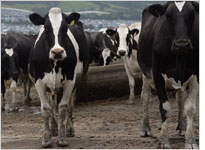
You've already weighed in on the question of whether veganism or vegetarianism is better for the environment. But I want more specifics: Which is better for the environment, soy milk or cow's milk?
First, a disclosure: The Green Lantern can't really stomach lactose and rarely drinks milk. But he isn't too keen on the taste of soy milk, either, so consider him a neutral arbiter when he concludes that soy is the somewhat more eco-conscious choice. That said, it's not easy to compare the two products: Soy milk may be packaged and marketed as a substitute for dairy, but environmentally speaking, it's a very different product. Start with the basics: The calcium in soy milk has to be artificially added, and you won't get anything remotely looking like milk from soy until you've ground up the beans; removed a fiber the Japanese call okara; and added water, vitamins, minerals, and sugar. Most cow's milk needs to be pasteurized and packaged, of course, but what you buy in the store is much closer to what comes off the farm.
We'll begin with the place where soy milk and cow's milk are most similar: as a source of protein. The Lantern has already discussed some of the environmental costs that come with raising cows—they require an enormous amount of energy to feed, they produce lots of waste, and they're a major emitter of methane. Dairy production is much more energy-efficient than raising cattle for meat, since you get more use out of each cow, but it's not as clean as growing crops. According to research (PDF) by Cornell University scientist David Pimentel, it takes about 14 calories of fossil-fuel energy to produce one calorie of milk protein on a conventional farm. Organically produced milk might require a little less than 10 calories of fossil-fuel energy, under the most optimistic assumptions, and better farming techniques could cut down greenhouse-gas emissions by at least 25 percent.
By comparison, Pimentel's data suggest that it takes about 0.26 calories of fossil fuel to make a calorie of organic soybeans—which are used by most soy milk manufacturers. Soy protein accounts for about 35 percent of those calories, so let's say you'll need to put 0.75 calories of energy into farming soy to produce a calorie of protein. That makes soy protein approximately 13 times more energy-efficient than even organic dairy protein under a best-case scenario. (Producing a kilogram of soybeans also yields significantly less greenhouse-gas emission than producing a kilogram of milk.)
Of course, as we've already discussed, you don't drink raw soy beans. Not only do the other ingredients in soy milk need to be shipped from elsewhere; the process of adding them requires energy and produces a significant amount of waste. As one British government report (PDF) put it, manufacturing soy milk is closer to making fruit juice than cow's milk. (And as the Lantern has noted before, producing fruit juice takes quite a bit of electricity.) Depending on how you feel about carbon offsets, the makers of Silk-brand soy milk—which accounts for about two-thirds of America's soy milk—may make the calculus easier since the company says it purchases wind power to compensate for the energy it uses in production.
Indeed, Silk's green marketing efforts offer an interesting case study in how a product's makeup isn't its environmental destiny. Despite animal-rights advocates' love of soy products, soybean producers aren't exactly the darlings of the environmental movement. The vast majority of soybeans are genetically modified (PDF); the Green Lantern may be agnostic about whether that's so bad, but the fact certainly hasn't made them popular among many green activists. In South America, farmers responding to the massive global demand for soy—fueled in large part by China—have been accused of doing lasting damage to the Amazon rainforest.
But because soy milk drinkers are, on the whole, an eco-conscious bunch, the products they buy tend to be made in a more sustainable way. In addition to the wind-power initiative, Silk's product line is almost entirely organic. Silk isn't perfect: The company is a bit evasive about what percentage of their soybeans are imported from abroad—a spokeswoman was unable to give the Lantern specific numbers—and its sale to the nation's largest milk processor in 2002 raised some eyebrows. But, generally speaking, the fact that its consumers are environmentally savvy probably makes for a greener product.
Nonetheless, niche products have their environmental downsides, too. A specialty product like soy milk—despite its growing popularity, its market is about one-twentieth the size of regular milk's—is probably going to have to travel farther to the average consumer simply because fewer people produce it. With more centralized production, that means the soy travels farther to the plant, too. Production probably has a much bigger environmental impact than transportation, but it's worth keeping in mind: Environmentally, it hurts to be in the minority.



No comments:
Post a Comment